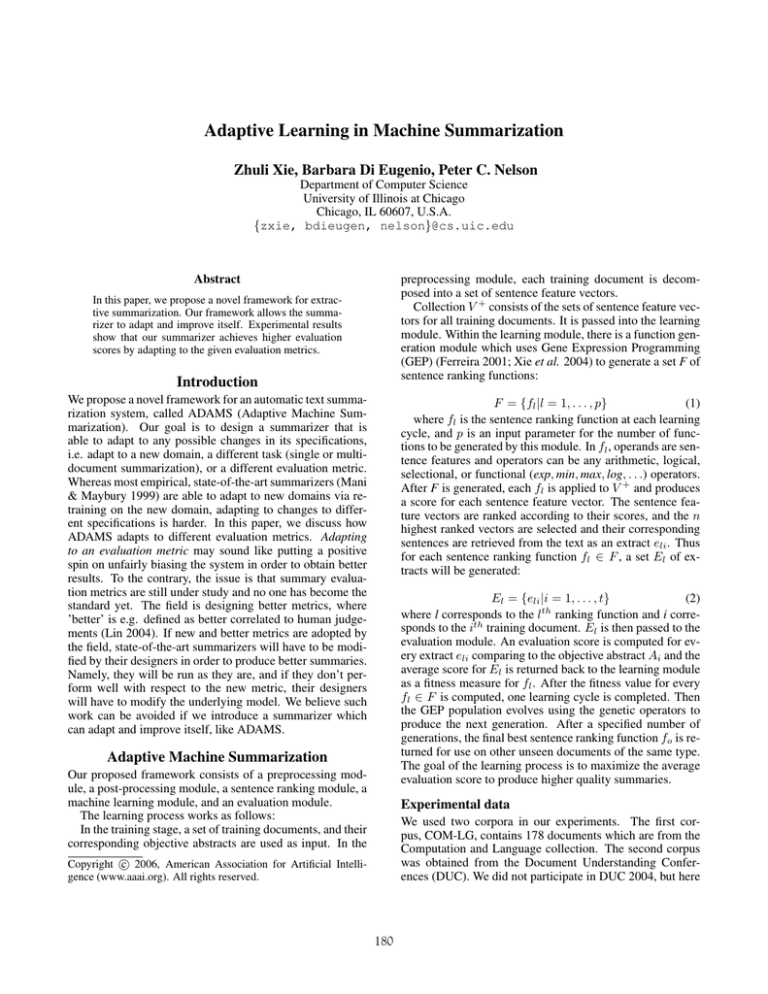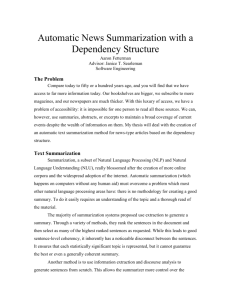
Adaptive Learning in Machine Summarization
Zhuli Xie, Barbara Di Eugenio, Peter C. Nelson
Department of Computer Science
University of Illinois at Chicago
Chicago, IL 60607, U.S.A.
{zxie, bdieugen, nelson}@cs.uic.edu
Abstract
preprocessing module, each training document is decomposed into a set of sentence feature vectors.
Collection V + consists of the sets of sentence feature vectors for all training documents. It is passed into the learning
module. Within the learning module, there is a function generation module which uses Gene Expression Programming
(GEP) (Ferreira 2001; Xie et al. 2004) to generate a set F of
sentence ranking functions:
In this paper, we propose a novel framework for extractive summarization. Our framework allows the summarizer to adapt and improve itself. Experimental results
show that our summarizer achieves higher evaluation
scores by adapting to the given evaluation metrics.
Introduction
We propose a novel framework for an automatic text summarization system, called ADAMS (Adaptive Machine Summarization). Our goal is to design a summarizer that is
able to adapt to any possible changes in its specifications,
i.e. adapt to a new domain, a different task (single or multidocument summarization), or a different evaluation metric.
Whereas most empirical, state-of-the-art summarizers (Mani
& Maybury 1999) are able to adapt to new domains via retraining on the new domain, adapting to changes to different specifications is harder. In this paper, we discuss how
ADAMS adapts to different evaluation metrics. Adapting
to an evaluation metric may sound like putting a positive
spin on unfairly biasing the system in order to obtain better
results. To the contrary, the issue is that summary evaluation metrics are still under study and no one has become the
standard yet. The field is designing better metrics, where
’better’ is e.g. defined as better correlated to human judgements (Lin 2004). If new and better metrics are adopted by
the field, state-of-the-art summarizers will have to be modified by their designers in order to produce better summaries.
Namely, they will be run as they are, and if they don’t perform well with respect to the new metric, their designers
will have to modify the underlying model. We believe such
work can be avoided if we introduce a summarizer which
can adapt and improve itself, like ADAMS.
F = {fl |l = 1, . . . , p}
(1)
where fl is the sentence ranking function at each learning
cycle, and p is an input parameter for the number of functions to be generated by this module. In fl , operands are sentence features and operators can be any arithmetic, logical,
selectional, or functional (exp, min, max, log, . . .) operators.
After F is generated, each fl is applied to V + and produces
a score for each sentence feature vector. The sentence feature vectors are ranked according to their scores, and the n
highest ranked vectors are selected and their corresponding
sentences are retrieved from the text as an extract eli . Thus
for each sentence ranking function fl ∈ F , a set El of extracts will be generated:
El = {eli |i = 1, . . . , t}
(2)
where l corresponds to the lth ranking function and i corresponds to the ith training document. El is then passed to the
evaluation module. An evaluation score is computed for every extract eli comparing to the objective abstract Ai and the
average score for El is returned back to the learning module
as a fitness measure for fl . After the fitness value for every
fl ∈ F is computed, one learning cycle is completed. Then
the GEP population evolves using the genetic operators to
produce the next generation. After a specified number of
generations, the final best sentence ranking function fo is returned for use on other unseen documents of the same type.
The goal of the learning process is to maximize the average
evaluation score to produce higher quality summaries.
Adaptive Machine Summarization
Our proposed framework consists of a preprocessing module, a post-processing module, a sentence ranking module, a
machine learning module, and an evaluation module.
The learning process works as follows:
In the training stage, a set of training documents, and their
corresponding objective abstracts are used as input. In the
Experimental data
We used two corpora in our experiments. The first corpus, COM-LG, contains 178 documents which are from the
Computation and Language collection. The second corpus
was obtained from the Document Understanding Conferences (DUC). We did not participate in DUC 2004, but here
c 2006, American Association for Artificial IntelliCopyright gence (www.aaai.org). All rights reserved.
180
we perform Task 2, creating a short (≤ 665 bytes) summary
for a given document cluster. We perform this task even if
ADAMS was not designed for multidocument summarization, in order to know how our system compares with the
participating systems and to assess whether it can be easily
adapted to this new task In our experiments with the DUC
data, 60 clusters of documents from DUC 2003 were used
for training, and 50 clusters from DUC 2004 were used for
testing. Each cluster contains about 10 documents.
ROUGE-1
Cosine Similarity
Ba
0.23178
0.28119
FC
0.42617
0.37525
FR
0.49235
0.30744
Table 1: Experimental Results for COM-LG Corpus
System
ADAMS
Baseline
Best
Worst
Evaluation metrics
Lin (2004) developed a summary evaluation system called
ROUGE which automatically determines the quality of a
summary by comparing it to objective summaries. He introduced ROUGE-N which is an n-gram recall measure between a candidate summary and a set of reference summaries. ROUGE has been used in DUC 2004 to evaluate
the summaries provided by the participants against humanwritten summaries. We use ROUGE-1 score and cosine similarity as summary evaluation metrics to show ADAMS can
adapt to them.
ROUGE-1
0.333
0.324
0.382
0.242
Table 2: Experimental Results for DUC Corpus
Table 2, along with that of ADAMS. At a ROUGE-1 score
of 0.333, ADAMS performs better than the baseline, and
lies in the middle compared with the participating systems.
This result is very promising given that our system was not
designed for multidocument summarization.
Conclusions and Future Work
Experimental settings and results
In this paper we propose a new framework for machine summarization. It allows the summarization system to generate better quality summaries by adapting itself to a “better” summary evaluation metric. Our experiments show that
ADAMS does possess the ability to adapt to different evaluation metrics. In future work we will investigate new metrics
which can be used in an automatic evaluation environment to
measure the overall quality (grammar, fluency, prominence,
relativeness, etc.) of the machine generated summaries.
For the COM-LG corpus, we have the following settings:
1. We use the first sentences from the first n paragraphs to
compose a lead-based summary (our baseline Ba).
2. We use cosine similarity as the evaluation metric to obtain
a ranking function FC .
3. We use ROUGE-1 as the evaluation metric to obtain a
ranking function FR .
In the testing stage, the sentence ranking functions learned
from the training stage are applied respectively to the unseen documents to each produce a set of summaries. Then,
we use the ROUGE evaluation system and cosine similarity
to compare those summaries with the abstracts of the unseen documents. For the DUC data, currently we only use
ROUGE-1 as the evaluation metric for both training and testing.
The first row in Table 1 shows the average ROUGE-1
scores of the ADAMS-generated summaries of unseen documents, compared with the corresponding abstracts. The
second row gives the average cosine similarity values between the summaries and the abstracts. To evaluate the performances of a summarizer, a lead-based method is widely
used in the literature on automatic text summarization and
many systems are just about the same as or little better than
it (Over & Liggett 2002). Our summarizer, however, greatly
outperforms the baseline method (see Table 1). We also see
that in the first row, FR is 14% better than FC since FR is
adapted to ROUGE-1; and vice versa in the second row, FC
is 22% better than FR . The results show that when a specific evaluation metric is used as the training target to obtain
a sentence ranking function f, the summaries produced by
f for the testing documents will get higher score than those
produced by other f’. In DUC 2004, 35 systems including one baseline participated in Task 2. The performances
of the best, the worst, and the baseline systems are shown in
References
Ferreira, C. 2001. Gene expression programming: A new
adaptive algorithm for solving problems. Complex Systems
13(2):87–129.
Lin, C.-Y. 2004. Rouge: a package for automatic evaluation of summaries. In Proceedings of the ACL-04 Workshop
on Text Summarization Branches Out (WAS 2004), 74–81.
Mani, I., and Maybury, M. 1999. Introduction. In Mani,
I., and Maybury, M. T., eds., Advances in Automatic Text
Summarization. The MIT Press.
Over, P., and Liggett, W. 2002. Introduction to duc-2002:
an intrinsic evaluation of generic news text summarization
systems. In Proceedings of the Document Understanding
Conference (DUC02).
Xie, Z.; Li, X.; Di Eugenio, B.; Xiao, W.; Tirpak, T. M.;
and Nelson, P. C. 2004. Using gene expression programming to construct sentence ranking functions for text
summarization. In Proceedings of the 20th International
Conference on Computational Linguistics, COLING-2004,
1381–1384.
181






